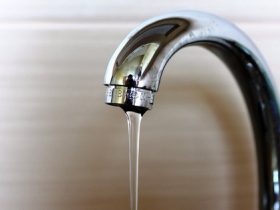Verified Methods for Fixing Low Water Pressure in Your Home
Verified Methods for Fixing Low Water Pressure in Your Home
Blog Article
Here on the next paragraphs you will find a lot of sound points with regards to 9 Reasons for Low Water Pressure in Your House.

Low water pressure in your house can be an aggravating issue, affecting whatever from showering to cleaning recipes. If you're experiencing weak water flow, there are a number of feasible causes and services to explore. In this overview, we'll talk about typical reasons for low tide stress and practical actions to attend to the issue effectively.
Introduction to Low Water Stress
Low water pressure takes place when the circulation of water from your faucets, showers, and other components is weaker than usual. This can make day-to-day jobs extra difficult and much less effective. Understanding the reasons for low water pressure is crucial to finding the right option.
Typical Causes of Low Tide Stress
Pipe Obstructions
Gradually, pipelines can end up being clogged with mineral deposits, debris, or particles, restricting the flow of water. This is a typical concern in older homes with galvanized steel pipes.
Corrosion
Deterioration within pipelines can cause leaks and decreased water stress. Corrosion build-up can tighten water circulation, specifically in aging plumbing systems.
Faulty Pressure Regulatory Authorities
Pressure regulatory authorities are in charge of preserving constant water stress in your house. If they malfunction, it can result in low water pressure or uneven flow throughout your home.
Local Water Supply Issues
Sometimes, the issue exists outside your home. Municipal supply of water problems, such as main line leakages or maintenance work, can momentarily lower water stress in your location.
Exactly How to Detect Low Water Pressure
Examining Taps and Fixtures
Start by evaluating the water stress at different faucets and fixtures throughout your home. If the problem is separated to certain areas, it might show localized problems.
Checking Pipelines
Examine noticeable pipes for indicators of leakages, deterioration, or clogs. Take notice of any unusual sounds, such as knocking or rattling pipes, which could indicate problems within the plumbing system.
Consulting with a Plumber
If you're incapable to pinpoint the reason for low tide stress, take into consideration working with an expert plumber to perform an extensive examination. They can determine underlying problems and recommend suitable options.
DIY Solutions to Deal With Low Tide Stress
Cleaning Up Aerators and Showerheads
Natural resources can build up in aerators and showerheads, decreasing water circulation. Remove and clean these components frequently to boost water stress.
Flushing Water Heater
Sediment accumulation in the water heater can limit flow and reduce efficiency. Purging the container periodically assists get rid of sediment and maintain ideal performance.
Inspecting Stress Regulatory Authority
Make certain that the stress regulator is functioning appropriately. Adjusting or changing the regulator can help recover proper water stress throughout your home.
Clearing Up Clogs in Pipeline
For minor blockages, attempt utilizing a plumbing snake or chemical drain cleaner to clear blockages in pipelines. Be cautious when utilizing chemicals and comply with safety guidelines.
When to Call a Professional Plumber
If do it yourself efforts stop working to settle the issue or if you suspect significant plumbing issues, it's best to look for aid from an accredited plumber. They have the knowledge and tools to resolve complex concerns safely and efficiently.
Preventive Measures to Preserve Water Stress
Normal Maintenance
Set up regular maintenance for your plumbing system to avoid issues such as deterioration, leaks, and blockages. Attending to minor troubles early can help stay clear of more substantial repairs later on.
Setting Up a Pressure Booster
Consider mounting a pressure booster pump to improve water pressure in areas with continually low flow. This can be particularly useful for multi-story homes or residential or commercial properties with high-demand components.
Surveillance Water Use
Be mindful of water usage routines and prevent overtaxing the plumbing system. Straightforward modifications, such as astonishing showers and laundry loads, can help preserve appropriate water pressure.
Verdict
Handling low tide pressure can be discouraging, however identifying the underlying causes and executing suitable solutions can bring back optimal circulation throughout your home. Whether it's cleaning aerators, examining pipes, or speaking with a plumber, taking aggressive steps can make certain a constant supply of water for your day-to-day demands.
FOUR WAYS TO FIX LOW WATER PRESSURE NOW
Turning on a shower or faucet only to find the water comes out in a sad, slow drizzle is never a good feeling. How exactly are you supposed to wash a pan or take a quick shower when it takes 10 minutes just to rinse off a little soap? The good news is that when your water pressure is bad, there's always a cause: typically one that can be easily fixed. Here are some of the most common causes of low pressure and what you can do to fix the issue:
DEBRIS AND MINERAL DEPOSIT BUILDUPS
If you notice low water pressure from just one or two of the fixtures in your house, the problem likely has to do with debris buildup. Water is full of minerals and other debris, all of which can accumulate in your pipes and on your fixtures. This can cause a blockage that affects how much water flows through. To fix this, try filling a small plastic bag with white vinegar, and use a rubber band to hang it around your showerhead or faucet. Let the head of the fixture soak for a few hours, and the vinegar should loosen the deposits.
WATER LEAKS
Leaks are another common cause of low water pressure. If water is flowing out of your plumbing through a hole or crack before it can reach your fixture, the pressure coming out of the faucet or showerhead will be lower. A plumbing professional is your best bet for finding and repairing a leak in your water supply pipes.
Leaks are another common cause of low water pressure. If water is flowing out of your plumbing through a hole or crack before it can reach your fixture, the pressure coming out of the faucet or showerhead will be lower. A plumbing professional is your best bet for finding and repairing a leak in your water supply pipes.
FOUR WAYS TO FIX LOW WATER PRESSURE NOW
Turning on a shower or faucet only to find the water comes out in a sad, slow drizzle is never a good feeling. How exactly are you supposed to wash a pan or take a quick shower when it takes 10 minutes just to rinse off a little soap? The good news is that when your water pressure is bad, there's always a cause: typically one that can be easily fixed. Here are some of the most common causes of low pressure and what you can do to fix the issue:
DEBRIS AND MINERAL DEPOSIT BUILDUPS
If you notice low water pressure from just one or two of the fixtures in your house, the problem likely has to do with debris buildup. Water is full of minerals and other debris, all of which can accumulate in your pipes and on your fixtures. This can cause a blockage that affects how much water flows through. To fix this, try filling a small plastic bag with white vinegar, and use a rubber band to hang it around your showerhead or faucet. Let the head of the fixture soak for a few hours, and the vinegar should loosen the deposits.
WATER LEAKS
Leaks are another common cause of low water pressure. If water is flowing out of your plumbing through a hole or crack before it can reach your fixture, the pressure coming out of the faucet or showerhead will be lower. A plumbing professional is your best bet for finding and repairing a leak in your water supply pipes.
Leaks are another common cause of low water pressure. If water is flowing out of your plumbing through a hole or crack before it can reach your fixture, the pressure coming out of the faucet or showerhead will be lower. A plumbing professional is your best bet for finding and repairing a leak in your water supply pipes.
A VALVE ISSUE
If you have low water pressure throughout your home, check your main shut-off valve to make sure it's completely open. You may also want to see if there's a pressure-reducing valve installed. If there is, have a plumber help you adjust the settings to get the pressure you're looking for.
OTHERS USING WATER
Believe it or not, your low water pressure could be caused by your neighbors. If you notice low pressure at certain times of day, it may be because you and the people living next to you have similar schedules - when everyone is showering at the same time, the pressure will be lower in every home. Low pressure throughout the neighborhood may also be caused by an issue with your municipal water supply. If that's the case, call the supplier to see if they're working on the issue.
https://www.rotorooter.com/blog/water-leaking/low-water-pressure-fixes/

We were made aware of that article on Low Water Pressure in the House? through a buddy on our other web address. So long as you liked our blog entry plz make sure you remember to pass it around. I love your readership.
Call Report this page